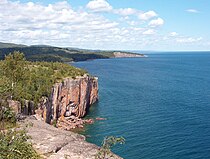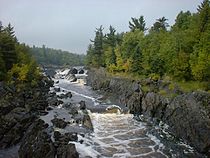
The Midcontinent Rift System (MRS) or Keweenawan Rift is a 2,000 km (1,200 mi) long geological rift in the center of the North American continent and south-central part of the North American plate. It formed when the continent's core, the North American craton, began to split apart during the Mesoproterozoic era of the Precambrian, about 1.1 billion years ago. The rift failed, leaving behind thick layers of igneous rock that are exposed in its northern reaches, but buried beneath later sedimentary formations along most of its western and eastern arms. Those arms meet at Lake Superior, which is contained within the rift valley. The lake's north shore in Ontario and Minnesota defines the northern arc of the rift. From the lake, the rift's eastern arm trends south to central lower Michigan, and possibly into Indiana, Ohio, Kentucky, Tennessee, and Alabama. The western arm runs from Lake Superior southwest through portions of Wisconsin, Minnesota, Iowa, and Nebraska to northeastern Kansas, and possibly into Oklahoma.
Formation and failure

The rock formations created by the rift included gabbro and granite intrusive rocks and basalt lavas. In the Lake Superior region, the upwelling of this molten rock may have been the result of a hotspot which produced a triple junction. The hotspot domed the rocks of the Lake Superior area. Voluminous basaltic lava flows erupted from the central axis of the rift, similar to the present-day rifting underway in the Afar Depression of the East African Rift system.
The southwest and southeast extensions represent two arms of the triple junction while a third failed arm extends north into Ontario as the Nipigon Embayment. This failed arm includes Lake Nipigon, Ontario.
The rift system may have been the result of extensional forces behind the continental collision of the Grenville Orogeny to the east which in part overlaps the timing of the rift development. Later compressive forces from the Grenville Orogeny likely played a major role in the rift's failure and closure. Had the rifting process continued, the eventual result would have been sundering of the North American craton and creation of a sea. The Midcontinent Rift appears to have progressed almost to the point where the ocean intruded. But after about 15–22 million years the rift failed. The Midcontinent Rift is the deepest closed or healed rift yet discovered; no known deeper rift ever failed to become an ocean.
The rift today

Lake Superior occupies a basin created by the rift. Near the present lake, rocks produced by the rift can be seen on the surface of Isle Royale and the Keweenaw Peninsula of the Upper Peninsula of Michigan, northwest Wisconsin, and on the North Shore of Superior in Minnesota and Ontario. Similar rocks are exposed as far south as Interstate Park near Saint Paul, Minnesota, but elsewhere the rift is buried beneath more recent sedimentary rocks up to 9 km (6 mi) thick. Where buried, the rift has been mapped by gravity anomalies (its dense basaltic rock increases gravity locally), aeromagnetic surveys, and seismic data.
A slightly older but possibly related geologic feature is the 2,700,000 km (1,000,000 sq mi) Mackenzie Large Igneous Province in Canada, which extends from the Arctic in Nunavut to near the Great Lakes in Northwestern Ontario.
Natural resources

The Proterozoic Nonesuch Shale formation in the Keweenawan Rift contains enough organic carbon (greater than 0.5%) to be considered a potential source rock for petroleum. Oil identified as Precambrian has been found seeping out of the Nonesuch Shale in the White Pine mine in Michigan. A few deep wells were drilled to explore for oil and gas in rift rocks as far southwest as Kansas. No oil and gas were found, but the explorations did make some deep rock samples available. These include two "dry holes" drilled by Amoco: a 7,238 ft (2,206 m) well in Alger County, Michigan in 1987 and 1988, and one in Bayfield County, Wisconsin to a depth of 4,966 ft (1,514 m) in 1992. In 1987 Amoco also drilled a 17,851 ft (5,441 m) dry hole that penetrated rift sediments in Iowa.
The Michigan Copper Country in the Upper Peninsula and Isle Royale contains major native copper deposits in Keweenawan-age rocks associated with the rift. A copper mining industry was developed in Precolumbian times, reactivated in the 1840s and continued for more than a century. Some low-grade copper and nickel deposits, among the largest in the world, also exist in the Duluth Complex north of the lake. Once thought to be uneconomic to mine, these deposits have attracted renewed interest from resource companies.
White hydrogen
White hydrogen could be found or produced in the Mid-continental Rift System at scale for a renewable hydrogen economy. Water could be pumped down to hot iron-rich rock to produce hydrogen and the hydrogen could be extracted.
Gallery
-
 Geological map of North America showing the Midcontinent Rift in white, here labeled Keweenawan Rift. Lake Superior now occupies the apex of the rift; the section to its north marked "SUPERIOR" is the Superior Craton
Geological map of North America showing the Midcontinent Rift in white, here labeled Keweenawan Rift. Lake Superior now occupies the apex of the rift; the section to its north marked "SUPERIOR" is the Superior Craton
-
Sleeping Giant in Ontario
-
 Eroded volcanic strata at Isle Royale in Michigan
Eroded volcanic strata at Isle Royale in Michigan
-
 A mafic sill at Thunder Bay, Ontario
A mafic sill at Thunder Bay, Ontario
-
 Cliffs at Palisade Head and Shovel Point in Minnesota
Cliffs at Palisade Head and Shovel Point in Minnesota
-
 Saint Louis River in Jay Cooke State Park in Minnesota
Saint Louis River in Jay Cooke State Park in Minnesota
-
Dalles of the St. Croix River at Interstate State Park, Minnesota-Wisconsin
See also
- Coldwell Complex – Landform in Thunder Bay district, Ontario
- Geology of Ontario
- Mamainse Point Formation
- Nemaha Ridge
- Volcanology of Canada – Volcanic activity in CanadaPages displaying short descriptions of redirect targets
- Volcanology of Eastern Canada – volcanic areas and lava formations in Eastern CanadaPages displaying wikidata descriptions as a fallback
References
- Stein, Carol (May 2018). "Is the "Grenville Front" in the central United States really the Midcontinent Rift?". GSA Today. 28 (5): 4–10. doi:10.1130/GSATG357A.1. Retrieved 1 May 2018.
- ^ "Middle Proterozoic and The Mid-continent Rift". Minnesota's Rocks and Waters. Winona State University. Retrieved 13 April 2008.(Powerpoint presentation)
- ^ Van Schmus, W. R.; Hinze, W. J. (May 1985). "The Midcontinent Rift System" (PDF). Annual Review of Earth and Planetary Sciences. 13 (1): 345–383. Bibcode:1985AREPS..13..345V. doi:10.1146/annurev.ea.13.050185.002021. hdl:1808/104. Retrieved 10 June 2007.
- ^ Ojakangas, Richard W.; Charles L. Matsch (1982). Minnesota's Geology. Illus. Dan Breedy. Minneapolis, Minnesota: University of Minnesota Press. ISBN 978-0-8166-0953-6.
- Kean, William F. (24 November 2000). "Keweenawan Rift System". Field Trips, Northern Wisconsin and Upper Michigan. University of Wisconsin-Milwaukee. Archived from the original on 6 July 2008. Retrieved 8 June 2007.
{{cite web}}: CS1 maint: bot: original URL status unknown (link) - ^ Ojakangas, R. W.; Morey, G. B.; Green, J. C. (1 June 2001). "The Mesoproterozoic Midcontinent Rift System, Lake Superior Region, USA". Sedimentary Geology. 141–142: 421–442. Bibcode:2001SedG..141..421O. doi:10.1016/S0037-0738(01)00085-9. (Abstract)
- ^ Reeves, T. K.; Carroll, Herbert B. (April 1999). "Geologic Analysis of Priority Basins for Exploration and Drilling" (PDF). U.S. Department of Energy, Office of Scientific and Technical Information. doi:10.2172/6060. Retrieved 10 June 2007.
{{cite journal}}: Cite journal requires|journal=(help) - Schneider, D. A.; Holm, D. K.; Chandler, V. (Fall 2006). A Superior Swath: Proterozoic Geology of the North American Midcontinent. American Geophysical Union. Bibcode:2006AGUFM.T42A..06S. Abstract #T42A-06.
- ^ Huber, Norman King (1975). "The story of Isle Royale National Park". Bulletin 1309. United States Geological Survey.
- Anderson, Raymond R. (25 November 2014). "Introduction to the Midcontinental Rift". Iowa Department of Natural Resources Geological Survey. Archived from the original on 4 January 2019. Retrieved 27 May 2016.
- Jol, Harry M. (2006). "Interstate State Park, A Brief Geologic History". University of Wisconsin at Eau Claire. Archived from the original on 15 December 2012.
- Interstate State Park Management Plan, Minnesota Department of Natural Resources Division of Parks and Trails] (2009), p. 26.
- ^ Palacas, James G. (1995). "Superior Province (051)" (PDF). National Oil and Gas Assessment. United States Geological Survey. Retrieved 10 June 2007.
- Daniels, David L.; Snyder, Stephen L. (1991). "Bouguer gravity anomaly map of north-central United States". Minnesota Geological Survey. hdl:11299/60081.
- Hinze, W.; Kellogg, D.; Merritt, D. (1971). "Gravity and Aeromagnetic Anomaly Maps of the Southern Peninsula of Michigan" (PDF). Report of Investigation 14. Michigan State Geological Survey.
- National Research Council; Division on Engineering and Physical Sciences; Commission on Physical Sciences, Mathematics, and Applications; Geophysics Research Board, Assembly of Mathematical and Physical Sciences, Geophysics Study Committee (1980). Continental Tectonics. National Academies Press. p. 180. ISBN 978-0-309-02928-5.
{{cite book}}: CS1 maint: multiple names: authors list (link) - Kucks, Robert P.; Hill, Patricia L. (2005). "Iowa magnetic and gravity maps and data". United States Geological Survey. Retrieved 3 September 2009.
- J.A. Seglund, "Midcontinent rift continues to show promise as petroleum prospect," Oil and Gas Journal, 15 May 1989, p.55-58.
- Albert B. Dickas, Results of the Middle Proterozoic Midcontinent rift frontier play along Lake Superior's south shore, Oil & Gas Journal, 18 September 1995, pp. 80–82.
- "Exploring the Midcontinent Rift". Iowa Geological Survey Resource Information Fact Sheet 2006-2.
- Kraker, Dan (2 December 2013). "FAQ: Everything you need to know about PolyMet". Retrieved 10 December 2013.
- Jira, Mark; David Southwick. "Mineral potential and geology of the Duluth Complex". Mineral Potential and Geology of Minnesota. Minnesota Geological Survey, University of Minnesota. Retrieved 13 April 2008.
- Kraker, Dan (5 December 2013). "PolyMet's copper-nickel mine rekindles decades-old environmental debate". Minnesota Public Radio. Retrieved 10 December 2013.
- "The Potential for Geologic Hydrogen for Next-Generation Energy | U.S. Geological Survey".
External links
- "Mineral Deposits of the Midcontinent Rift System". United States Geological Survey Mineral Resources Program, Eastern Mineral and Environmental Resources Science Center. A detailed and well-illustrated resource focusing on the mineral resources of the Midcontinent Rift and its geologic history.
- Stein, Seth et al. (2016) "New Insights into North America’s Midcontinent Rift". Eos, 97, https://doi.org/10.1029/2016EO056659.
Categories:
- Aulacogens
- Geologic provinces of the United States
- Geology of Alabama
- Geology of Indiana
- Geology of Iowa
- Geology of Kansas
- Geology of Kentucky
- Geology of Michigan
- Geology of Minnesota
- Geology of Nebraska
- Geology of Ohio
- Geology of Oklahoma
- Geology of Ontario
- Geology of Tennessee
- Geology of Wisconsin
- Mesoproterozoic rifts and grabens
- Large igneous provinces